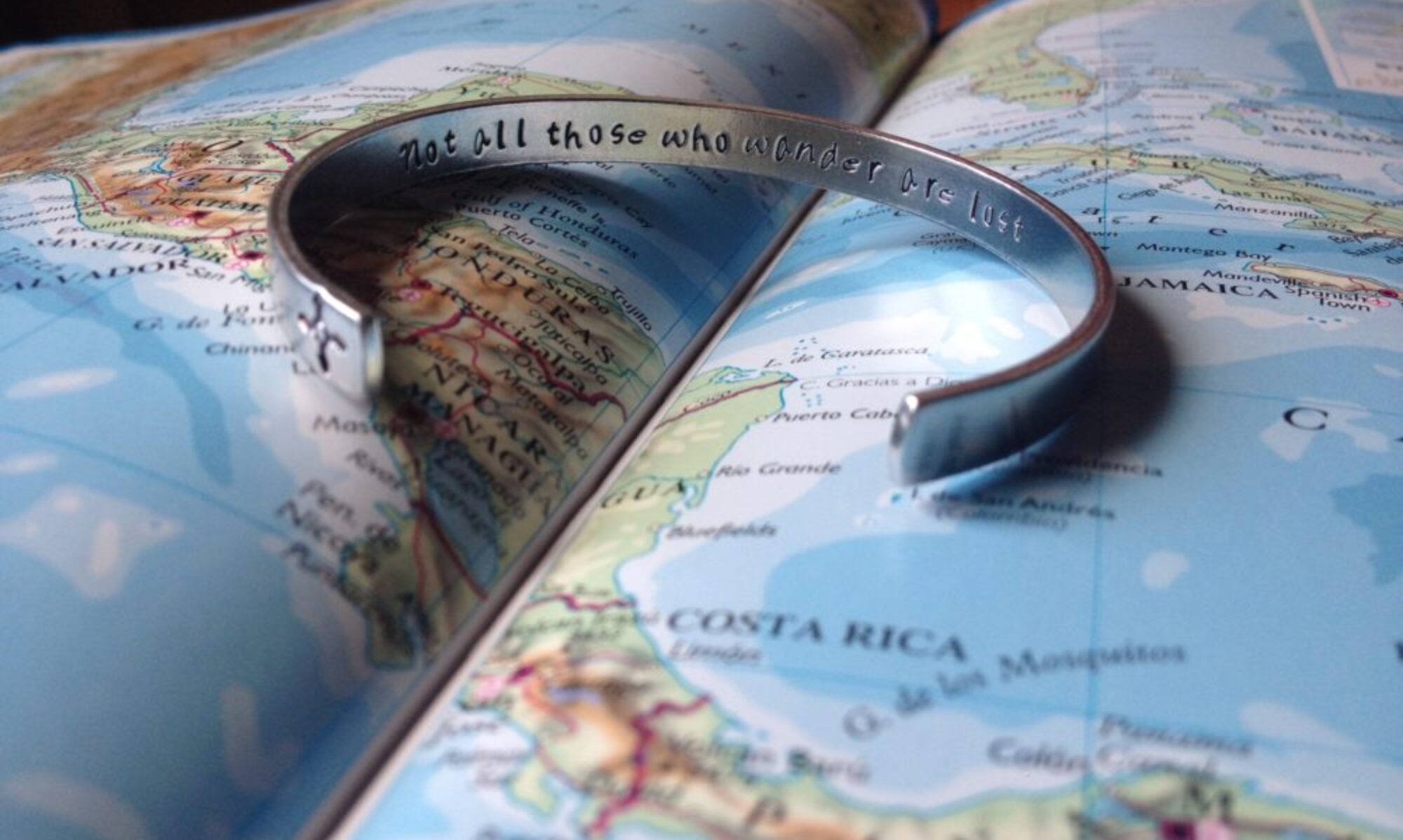“So, let us be alert in a twofold sense: Since Auschwitz we know what man is capable of. And since Hiroshima we know what is at stake.”
― Viktor E. Frankl
Wars are never good. But there are worse things, and until the year 1940 – probably nobody knew of them. Even as we march proudly through the 21st century, making ungodly advancements almost every single day, some parts of this discomfiting past are being left behind.
In school, we were taught about the World Wars, but I have no recollection of discussing the Holocaust. Most of my education was at home, through my father – who has passionately read about and passed the fervor down to me – something I am most grateful for.
For those who are not aware, Auschwitz-Birkenau was the largest German Nazi Concentration and, since 1942, Death Camp built on the occupied Polish territory. Operating between May 1940 and January 1945, it started out as a work camp and became one of the only places which combined the abuse of slave workforce and gas chambers. Since 1942, Birkenau, which is located at a three-kilometer distance from Auschwitz I, was adapted to be the center for mass extermination of European Jewry. It is estimated that over 1.3 million people, mainly Jews were murdered in these two camps as a part of the Nazi ethnic cleansing agenda.
While visiting Auschwitz-Birkenau, I did not want the experience to be one of mass tourism – with a group of 20 walking behind a tour guide who couldn’t wait for the three hours to conclude and rushed through most of it. After days of intensive research, I came across
Polin Travel – a firm and research center established in Kraków by Polish history and genealogy scholar, Tomasz Cebulski. While their major focus is towards Jewish and genealogy services, Tomasz and his associates undertake the occasional guiding tour. From the moment I browsed through his website and perused through the
TripAdvisor reviews, it was clear that this was more than a job for him. The choice was even simpler, when I saw the itinerary that he had set for the day – starting from the Kraków Ghetto, all the way to Oświęcim. I couldn’t be more pleased about selecting Tomasz to show us this part of this country’s history.
It was our second day in the royal city of Kraków – we were met at our hotel at 9 sharp by Tomasz and almost immediately delved into the times of old. We drove through the erstwhile ghetto and Jewish quarter in what is known as Podgorze. Our first stop was Zgody Square in the heart of Jewish part of the city, which was the main place for the deportation of the city’s Jews. What seemed like just another public square today, had a number of large empty metal chairs distributed throughout the space.
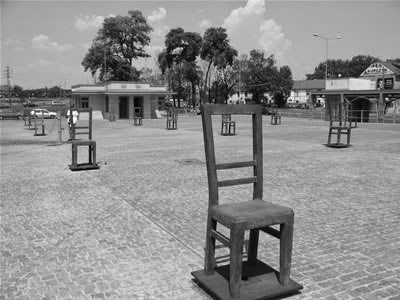 |
| Emptiness – At Zgody Square |
Tomasz told us that as the ghetto’s largest open space, Plac Zgody was a place for people to socialise, relax and escape the oppressive overcrowding of the tenements. Subsequently, it became the site of families being torn apart, mass deportations to the death camps, beatings and executions. Following the final liquidation of the ghetto, the “Umschlagplatz” (deportation square) was strewn with furniture, clothes, luggage and other belongings that the victims had been forced to abandon. The chairs were an evocative monument, meant to symbolise departure, as well as subsequent absence. It was stirring, to look upon such a place and what it signified.
Tearing ourselves away from the sight, we drove to Schindler’s factory next – which is probably more popular owing to the Steven Spielberg motion picture on the life and work of Oskar Schindler – the multiple Academy Award winning
Schindler’s List. The once enamelware factory at 4, Lipowa Street is now a museum which hosts a permanent exhibition entitled
‘Kraków under Nazi Occupation 1939-1945’, which we did not have time to see, but it is most recommended.
 |
| The original factory gates |
 |
| Schindler’s Factory today |
With Tomasz telling us unimaginable stories of the Krakow ghetto as we drove on forward away from the city and came to what looked like a large expanse of green, looking like the most convincing meadow. We were stunned on being told that these were the bygone terrains of the Płaszów Camp. It is hard to go anywhere in Poland without being reminded of one of the darkest chapters in the history of humanity, and Kraków, for all of its beautiful and intoxicating diversions, isn’t any different. Most tourists use Kraków as a jumping-off point for visiting Auschwitz-Birkenau, while few seem to realise that Kraków actually has a former concentration camp in its own backyard. You would think it might be because it was lesser known, but it isn’t.
The entire premise of Schindler’s List was based on this camp, which is today reduced to dust. From February 1943, the Commander of Płaszów camp was the devious SS-Untersturmfuhrer Amon Goeth (played by the brilliant
Ralph Fiennes in Schindler’s List). He was previously supervising death camps in Belzec, Sobibor and Treblinka and lived in a cottage right on the edge of the camp – the villa still stands. The site of the former Płaszów concentration camp remains largely as it was when the Nazis abandoned it close to 70 years ago – flattened to the ground – with zero proof of its existence save survivor accounts. Today, there are no group tours here, just a sign asking visitors to respect the history and a poignant monument– known as the
‘Memorial of Torn-Out Hearts’ which is most heart-rending.
 |
| All that remains is a sign |
 |
| Plaszow |
 |
| The memorial, from a distance |
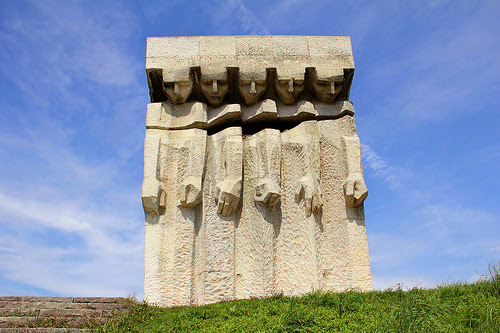 |
| Heart-wrenching, up close |
Continuing the hour-long and very picturesque drive to Auschwitz and Birkenau, Tomasz told us more about the war-stricken Poland and the plight of the Jewish community within. Having worked with a number of survivors, his experiences were both enlightening as well as haunting. As we passed the Auschwitz III – Monowitz – IG Farben complex, the topic of sub-camps came up and to our shock, we were told that some of the companies under the IG Farben conglomerate (the single largest donor to the election campaign of Adolf Hitler), still function today, one of them being the pharmaceutical giant – BASF.
On reaching the territory and structures of the former Auschwitz I, which were converted into a State Museum in 1947, we went on to visit the various buildings which are now transformed into permanent exhibitions. I had to stop for breath, as we came to the “Arbeit Macht Frei” (Works makes you free) sign which marks the entrance. All of us had separate receivers with headsets and Tomasz spoke to us softly through his microphone – standing at a distance.
 |
| First sighting. |
As we walked through, we were told that at first, the Germans held Polish political prisoners in the camp – but it only escalated therefrom. From the spring of 1942, Auschwitz became the largest site for the murder of Jews brought here under the Nazi plan for their extermination – better known as the “The Final Solution”. More than 1,100,000 men, women, and children lost their lives here.
It is impossible to describe in words how it felt to walk through quarters in which thousands were squeezed in, living in situations worse than cattle – and most importantly, sans hope. We passed through rooms over rooms with scores of relics in the form of shoes, human hair, travel cases, spectacles and kitchen ware among many others. The dramatic authenticity of the tragedies that took place here would shake up everything you think you might know about the human race and the cruelties that we are capable of.
 |
| An orchestra played, here – apparently to up the morale of workers |
 |
| Brick barracks which once belonged to the Polish Army |
 |
| Jews were asked to write their names on the cases, so that it would be easy for them to locate, later. |
 |
| Glass cases full of mismatched shoes |
 |
| So peaceful, today. |
 |
| Corridors on corridors of faces |
 |
| Remnants. |
 |
| Death Wall, near the dreadful Block 11 |
Another very significant thing we can thank Tomasz for, was to take us to
‘Shoah’ – a new permanent exhibition by Yad Vashem that is hosted in Block 27 at the Auschwitz-Birkenau State Museum. He mentioned to us that in witnessing the catastrophes, we forget to think of the individuality of the people who lived prior to the incidents. A portion of the museum focuses on pictures and videos of Jewish families from across Europe – picnicking in the garden, children on swings made of old tires, relatives coming together for religious and social occasions. These were regular people with regular families – just like you and I are today.
I could go on for pages and pages about the contents of the exhibit, but what I must highlight is a special chamber which almost reduced me tears. Nazi ideology not only blamed the Jewish people for the world’s troubles, but also targeted every single Jewish child for annihilation – the most extreme expression of genocide. Artist Michal Rovner was approached to create a work for the space devoted to the 1.5 million Jewish children murdered during this time. His idea was to present fragments of original drawings by children during the Shoah copied onto the wall of the space dedicated to their memory – I couldn’t stop but take pictures of what those minds had perceived, on having their homes, parents, freedom and all voice wrenched away from them – see for yourselves.
 |
| For mother. |
 |
| Memorial book with the names of the 68864 prisoners who died at Auschwitz |
When we had completed seeing the grounds, not having realised that more than five hours had passed, we stopped for a spot of lunch, and then drove onward to the second part of the monstrous plan – the bigger evil – Auschwitz II Birkenau.
On the way, we stopped at the Altejudenrampe (Old Jewish Unloading Platform) where two cattle rail cars stand, to commemorate the place. It was in these, that Jews from around Europe were packed and made to journey for days, without food or water.
 |
| The place where Rudoph Hoess, Commandante of Auschwitz was hanged in 1947 |
Unlike the main camp at Auschwitz, Birkenau is not a museum, research archive, or publishing house. It is preserved more or less in the state it was found at liberation in January 1945. However, only a few of the wooden and brick barracks and other structures in the women’s camp still stand. All four Birkenau gas chambers and crematoria were dynamited by the retreating SS, however their ruins can still be seen. We climbed the stairs up to the main watch tower from where the very familiar railway tracks and unloading platform came into view. Tomasz told us then, that when survivors come back here, they exclaim mentioning, “Where did all this green come from?” When the camp was in full operation, there would be mud and slush everywhere – unlike the carpet of grass that today’s visitors will see.
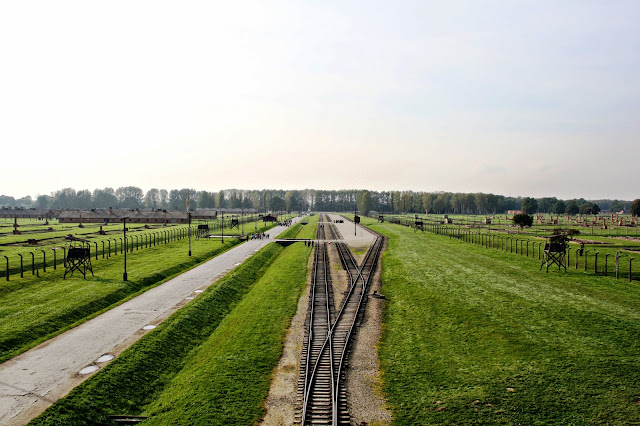 |
| From the watch tower |
 |
| Tomasz |
 |
| In memory |
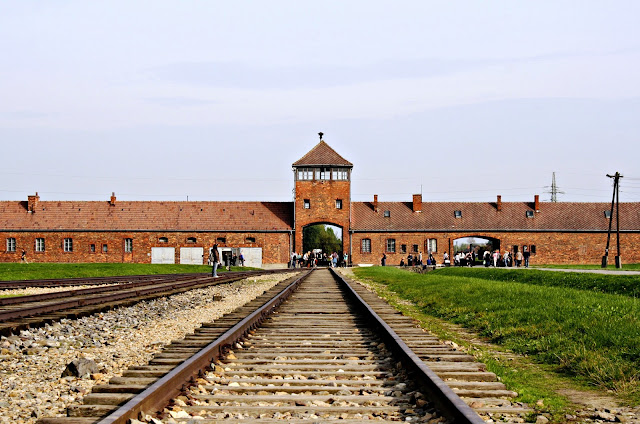 |
| The postcard Birkenau |
 |
| Restored wooden barracks |
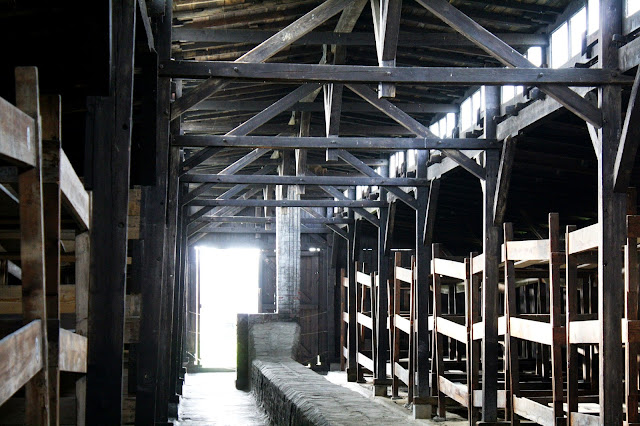 |
| With the 5 people on each bunk, beds |
 |
| Latrines |
 |
| Sorting platform |
The remaining former camp structures are spread over vast territory (over a kilometre), the general number of victims as well as their diversified nationality led Auschwitz to be recognized as the main symbol of Holocaust in the world. Each year the Auschwitz-Birkenau Museum is visited by approximately 1 and half million visitors, who choose to learn the history of the Holocaust.
 |
| Ruins of the Gas Chamber and Crematorim |
 |
| Leveled to the ground |
While reading about Birkenau, I came across this, on Remember.org and I could not say it better.
“This is not a pleasant site, not one that will distract from the pressures of everyday existence. But Birkenau, the largest and most lethal of the Auschwitz camps, is as much a part of the world as any aspiration for freedom and peace. In this sense, we feel the need to constantly explore this place and the ideas that created it, in the hope that eventually we will understand why people do such terrible things to other human beings, and why some were able, despite the tremendous role luck played, to find the strength to survive it. The search for this kind of meaning has, as paradoxical as it may sound, enriched our lives.”
Auschwitz-Birkenau is not a vacationers’ bliss, but to me it feels absolutely imperative to visit at least once in a lifetime. The ashes of over 1.5 Million innocent lie over the ground you walk over – wouldn’t you think it deserves a day from our lives to pay homage and a moment of silent prayer.
As they say, and I hope, “Never again, Auschwitz.”



